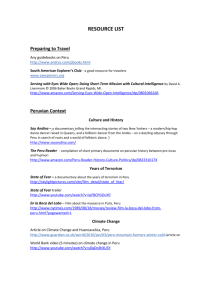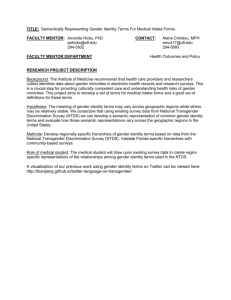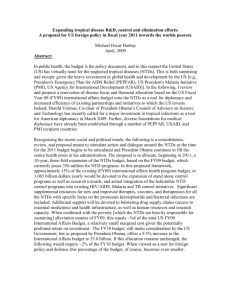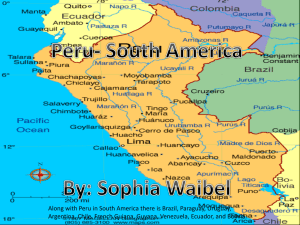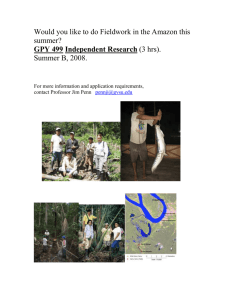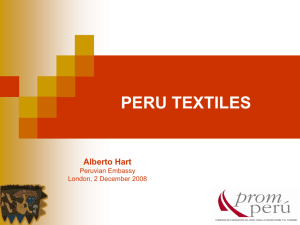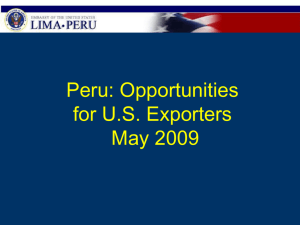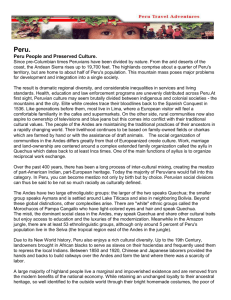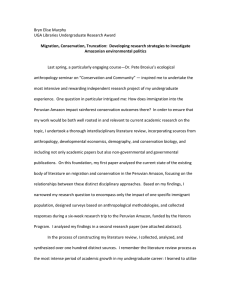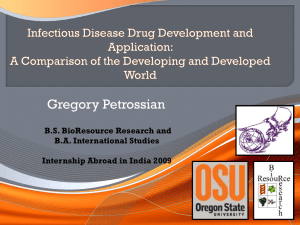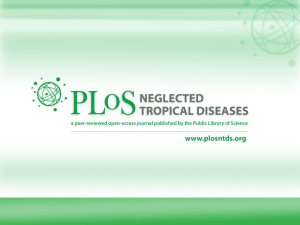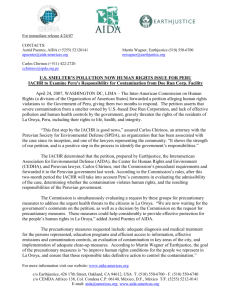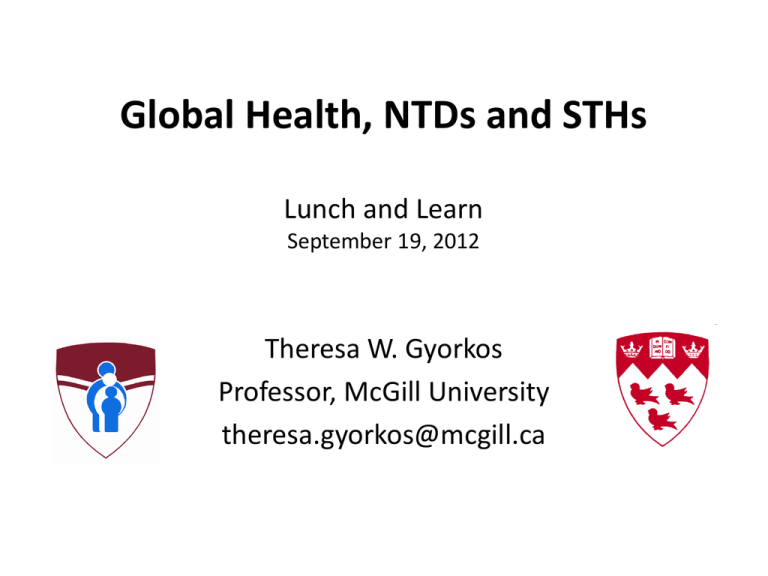
Global Health, NTDs and STHs
Lunch and Learn
September 19, 2012
Theresa W. Gyorkos
Professor, McGill University
theresa.gyorkos@mcgill.ca
Outline
• Introduction to Global Health, NTDs and STHs
• Research examples
– Research questions
– Study designs
– Study populations
• Research implications
• Opportunities for students
– Scholarships, plus
– Careers
• Global health can be regarded as population health
on a trans-national scale.
• Global health research therefore focuses on the
determinants and distribution of health and disease
that affect human populations in more than one
country.
Examples: pandemic transmission/control; migrationrelated health concerns; communicable disease
transmission from contamination of imported foods;
health personnel migration issues
06-01-12 The Gazette
Global Health Journals
Global Public Health
Global Health Action
Global Health Governance
Global Health Promotion
Journal of Global Health Protection
(now Emerging Health Threats)
International Health (via TRSTMH)
Lancet
Bulletin of the WHO
PLoS ONE, PLoS NTD, etc.
...
Journal of Globalization and Development
...
Why study global health?
•
•
•
•
•
•
•
learn from past to improve current and future health
health concerns are not restricted to any one country,
region or continent
address current/future health in a collaborative way
address health disparities at all levels (local, provincial,
national, regional, international)
intricate link between health and development
make more effective and efficient use of increased
funding for global health activities
…
Neglected Tropical Diseases (NTDs)
(N= 17)
Buruli ulcer
Chagas disease
Cysticercosis
Dengue
Dracunculiasis
Echinococcosis
Fasciolosis
Sleeping sickness
Leishmaniasis
Leprosy
Lymphatic filariasis
Onchocerciasis
Rabies
Schistosomiasis
Soil-transmitted helminthiasis
Trachoma
Yaws
Neglected Tropical Diseases
(NTDs)
> 1 billion people affected...
in 149 countries...
> 70% with ≥ 2 NTDs...
(Ref: WHO 2009)
Neglected Tropical Diseases
(N = 17)
Buruli ulcer
Chagas disease
Cysticercosis
Dengue
Dracunculiasis
Echinococcosis
Fasciolosis
Sleeping sickness
Leishmaniasis
Leprosy
Lymphatic filariasis
Onchocerciasis
Rabies
Schistosomiasis
Soil-transmitted helminthiasis
Trachoma
Yaws
Burden of STH Disease
(infecteds and ill in millions; deaths in thousands)
Deaths
Infecteds
Ill
Roundworms
(Ascaris)
1,472
350
60
Whipworms
(Trichuris)
1,049
220
10
Hookworms
1,298
159
65
>2,000
447
135
STH
Parasitol Today 1997; WHO 2002; Crompton & Nesheim 2002; WHO 2006
Roundworms: adverse effects
• Acute pulmonary disease
• Hypersensitivity
• Intestinal obstruction
Whipworms: adverse effects
•
•
•
•
Rectal bleeding
Rectal prolapse
Iron-deficiency anemia
Chronic dysentery
Hookworms:
adverse effects
• Iron-deficiency anemia
• Blood loss:
– Up to.4 ml/day/worm
HIGH RISK GROUPS
• PRE-SCHOOL CHILDREN
• SCHOOL-AGE CHILDREN
• WOMEN of REPRODUCTIVE AGE
DEWORMING...
improves cognition, growth, nutrient uptake…
decreases absenteeism…leads to higher wages
increases enrollment; improves dropout/retention
improves survival, growth and development
reduces maternal anaemia
reduces other diseases/improves overall health
decreases environmental contamination
mobilizes drug resources
Research partnership Canada- Peru: 2001 - present
Belen
Health/education
systems
School
Household
2001
KAP
2002 2003-05 2005
DIET
pregnant women
parasitology
2005-06
2006-11
2012-
RCT
Tropical Medicine
Research Centre
infants
schoolchildren
nutrition
community
multidisciplinary
POLICY
• Regular (anthelminthic) chemotherapy to at least 75%
of all school-age children at risk of morbidity by 2010
(and to promote health education through
intersectoral collaboration)
• Developed 1998-1999
• Approved by WHO Cabinet - October 2000
• Approved by World Health Assembly - May 2001
Previous research: RCT in Peru 2003-2005
Pregnant women
N=1042
Mebendazole
+
Iron supplementation
Placebo
+
Iron supplementation
BW
BW
One RESULT: VLBW (0% vs 1.5%, p=0.007)
OR=0.10 (0.0, 0.68)
Planned research: RCT in Peru 2012-2014
Lactating women
N=1010
Albendazole
Placebo
Infant weight gain
from birth to 6 months
of age
Infant weight gain
from birth to 6 months
of age
Infant weight gain
from birth to 24 months
of age
Infant weight gain
from birth to 24 months
of age
Student research questions
• François Thériault: Short and long-term effects of a health education
program on helminth infection and absenteeism rates in Grade 5
students of the Peruvian Amazon
• Brittany Blouin: The effect of early versus late umbilical cord
clamping on newborn anemia: implications for clinical practice in the
Peruvian Amazon
• Kathleen Rollet: Exploring health inequalities: determinants of
home-based versus hospital-based deliveries in the Peruvian Amazon
• Sarah Carsley: Sex and gender differences in hookworm infection in
school-age children in Peru
• Sonya Cnossen: Determinants of participation in a milk subsidy
program (Vaso de Leche) in a poor community in the Peruvian
Amazon
• Mathieu Maheu-Giroux: An eco-epidemiological study of the impact
of fish farming (‘pisicigranjas’) on malaria occurrence in the Peruvian
Amazon
• Hélène Carabin: Enviro-net: Efficacité d’un programme de contrôle
des infections et des contaminants de l’environnement dans les
garderies
Challenges of field-based evidence
•
•
•
•
•
•
•
•
Multidisciplinary/participatory approach
Local supervision
Rigorous study designs
Sufficient sample sizes
Proper assembly of study populations
Rigorous stool examination methods
Rigorous statistical analyses
Results dissemination to appropriate audiences
Ultimate goal:
provide rigorous evidence base for cost-effective
prevention and control activities
Opportunities for Students
• Thesis research
– Primary epidemiology, primarily
– Manuscript-based
– LMIC-based (Peru, etc.)
• Scholarships
– CIHR, FRQ-S,NSERC,IDRC ...
– STIHR (GHR-CAPS) - Ēcole d’été 2013,
– Travel awards
– Best theses (RRSPQ)
Opportunities for Students
• Leadership
– CCGH (Ottawa, October 21-24, 2012)
– CCGHR (UAC, etc.)
• Internships
– WHO
– PAHO
• Bulletin SantéPop (RRSPQ)
• Bulletin de Nouvelles, Axe en santé mondiale,
(RRSPQ)
Careers in Global Health
• Academia
• Government agencies
– CIDA, IDRC, PHAC, PAHO, WHO,...
• NGOs
– Micronutrient Initiative
– Médecins Sans Frontières
– ....
• Industry
– Pharmaceutical
– ...

